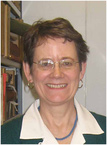 When Melissa Bullard tracked down the origins of a family heirloom, she embarked on an exciting new project far afield from her usual work. An expert on the Italian Renaissance, who has published widely on the Medici family and Italian finance, Bullard’s latest book, Brooklyn’s Renaissance: Commerce, Culture, and Community in the Nineteenth-Century Atlantic World (Palgrave, 2017) led her to the very different field: 19th-century U.S. history and the Atlantic World.
When Melissa Bullard tracked down the origins of a family heirloom, she embarked on an exciting new project far afield from her usual work. An expert on the Italian Renaissance, who has published widely on the Medici family and Italian finance, Bullard’s latest book, Brooklyn’s Renaissance: Commerce, Culture, and Community in the Nineteenth-Century Atlantic World (Palgrave, 2017) led her to the very different field: 19th-century U.S. history and the Atlantic World.
Originally from California, Bullard had never been to Brooklyn before seeking out the origins of a family portrait. Its subject, Luther Boynton Wyman (1804-1879), was a merchant with the famed Black Ball Line of Liverpool packets, one of the most important Atlantic shipping companies in the nineteenth century. Wyman was also a major patron of the arts in Brooklyn.
Bullard spotted a wider trend. “I had a sense of Renaissance as a cultural flowering,” she said. “When I came to nineteenth-century Brooklyn history, I recognized what was happening there to be a cultural movement –a kind of Renaissance. I think other scholars may not have recognized all the connections between commerce and culture there, but rather considered the newly formed Brooklyn Philharmonic Society, Academy of Music, and Arts Association in isolation. But to observe so many cultural foundations emerging together and at the hands of people engaged in transatlantic commerce” struck her as an exciting echo of the Italian Renaissance.
Brooklyn’s Renaissance offers the backstory to present-day Brooklyn’s character as an arts-friendly community. Bullard studied how nineteenth-century Brooklyn, soon to be third largest city in the U.S., was eager to bolster an image of itself as a cultural center separate from Manhattan. A group of commercial professionals, working together, established an “amazing number of cultural associations over a short period of time.” These Renaissance-style patrons “longed to have the cultural amenities a city Brooklyn’s size warranted,” Bullard said. “And they were tired of having to cross the East River to go to Manhattan for an evening performance of the philharmonic orchestra or to attend a lecture.”
As she continued her research, Bullard “began to see parallels between what was happening in nineteenth-century Brooklyn and what had occurred in Italy in the fifteenth and sixteenth centuries,” she said. One major parallel concerned how a mercantile elite purposefully promoted the cultural affairs of their city and used culture to create community bonds. This model resembled the merchant patronage the Medici had fostered in Italy.
The Brooklyn patrons of the arts Bullard studied were emulating the parallel she explored. These Brooklynites drew upon their transatlantic networks, especially in Liverpool. That city had experienced its own cultural flowering a generation earlier, and key figures there “had fallen in love with the Italian Renaissance” and even styled themselves and their city after the Florence of Lorenzo de’ Medici.

Bullard began her Brooklyn adventure after completing a major two-volume project. For her next book, she decided she “wanted to do something completely different.” She challenged herself to publish a substantial piece of scholarship in a new field. To some extent, she said, it was a personal dare of “let’s see if I can do it.” Bullard was grateful for an opportunity to turn her well-honed historical skills towards a new subject. “Everything was an exciting discovery because it was a new area for me,” she said. But not all aspects of the project were new. Bullard’s previous work relied heavily on extensive archival research, and this project was no different. She “felt very much at home plowing through account books and letters in London and Liverpool and in Brooklyn, New York, Boston, and Philadelphia.”
Her focus on the nineteenth century brought some added benefits. Compared to the challenge of deciphering five-hundred-year-old Latin and Italian manuscripts, research in a relatively recent century—in a primarily English-speaking community—presented far fewer paleographic obstacles. This project also allowed Bullard to work extensively with newspapers, a source-base unavailable in the Italian Renaissance. She is currently developing a website with historic maps that track the dynamics of Brooklyn’s Renaissance during this crucial time.
Bullard urges other scholars to venture beyond the boundaries of their formal academic training. “Go for it!” she said, “It’s exciting, it’s invigorating, and it will make you a better historian because you will gain a much broader comparative perspective.”
At the same time, she recognized that this flexibility may not be available to junior scholars. One must develop a “solid base” and “thorough engagement” in a particular field before expanding outward. Bringing her skills and perspective to a new field was “a plus,” Bullard said, “but it was also a luxury that as a senior scholar I could indulge.”
–Joshua Tait
